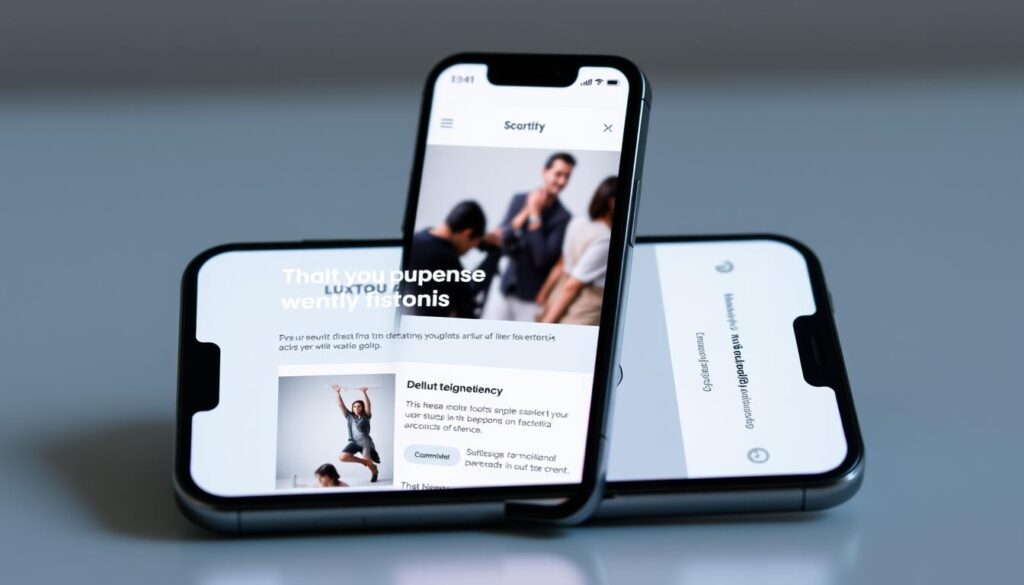Did you know that mobile devices accounted for nearly 57% of website traffic? This staggering statistic underscores the importance of having a website design that caters to mobile users. As the digital landscape continues to shift towards mobile usage, a mobile website is no longer a luxury, but a necessity for businesses.
Google’s move towards mobile-first indexing means that the mobile version of a website’s content is now paramount for ranking and indexing. A well-designed mobile website directly impacts user experience, a critical factor in both search engine rankings and conversion rates. Businesses that fail to optimize for mobile risk turning away more than half of their potential visitors and customers.
In this article, we’ll explore why having a website that is optimized for mobile is crucial for SEO performance and conversion optimization, backed by current statistics and industry best practices.
The Mobile-First Revolution in Digital Marketing
Google’s shift towards mobile-first indexing has marked a new era in digital marketing. This significant change reflects the evolving behavior of internet users who are increasingly relying on mobile devices for their online activities.

Google’s Mobile-First Indexing Timeline
The journey towards mobile-first indexing began in earnest when Google announced its mobile-friendly update in 2015, an event many in the industry referred to as “Mobilegeddon.” Google’s timeline for mobile-first indexing shows a clear progression: from the initial algorithm update in 2015 to the start of mobile indexing in March 2018, and finally to full mobile-first indexing by 2019.
This shift was not arbitrary but reflected the changing behavior of internet users who increasingly turned to smartphones and tablets for their online activities. As a result, mobile website design has evolved from being a simplified version of desktop sites to becoming the primary design consideration for web developers.
The Shift in User Behavior Towards Mobile Devices
The transformation in user behavior has been dramatic, with mobile searches surpassing desktop searches several years ago and continuing to grow. Understanding this shift is crucial for businesses that want to remain competitive in the digital marketplace. The mobile site experience now dictates how users perceive brands, with poor mobile experiences leading to negative brand associations.
As marketing strategies have had to adapt to this new reality, mobile-optimized content, advertisements, and user journeys have become standard practice. Ensuring a seamless user experience across various devices is now paramount for businesses aiming to thrive in the digital landscape.
Key Statistics That Prove the Importance of Mobile-Friendly Websites
With the majority of web traffic now coming from mobile devices, businesses must prioritize mobile-friendly website design. The statistics surrounding mobile web usage are compelling and have significant implications for businesses across various industries.

Mobile Traffic Accounts for 57% of All Web Traffic
According to a recent study, mobile devices accounted for nearly 57% of website traffic. This statistic underscores the importance of mobile website design in today’s digital landscape. The shift towards mobile browsing is not just a trend; it represents a fundamental change in how users interact with websites.
- Mobile traffic now accounts for 57% of all web traffic, representing a significant majority of online users.
- This shift has profound implications for businesses, from retail to professional services, as they need to adapt their online presence to cater to mobile users.
How Mobile Usage Affects Conversion Rates
The impact of mobile usage on conversion rates is a critical consideration for businesses. While conversion rates on mobile devices have historically been lower than on desktops, this gap is closing as mobile website design improves.
- Businesses with mobile-friendly websites see significantly higher conversion rates from mobile users compared to those with non-optimized sites.
- The correlation between mobile optimization and conversion rates is particularly strong in e-commerce, where streamlined checkout processes and clear product information are essential.
These statistics highlight the importance of having a mobile-friendly website that provides a seamless user experience across different devices and screen sizes. By optimizing their websites for mobile users, businesses can improve key performance indicators like bounce rates, time on site, and pages per session, ultimately driving more conversions and sales.
How Mobile-Friendly Websites Impact SEO Rankings
Mobile-friendliness is no longer just a recommendation; it’s a necessity for achieving and maintaining high SEO rankings. As Google continues to refine its algorithm, the emphasis on mobile usability has become a critical factor in determining a website’s search engine ranking.

Google’s Algorithm Updates Since 2015
Since 2015, Google has implemented several algorithm updates that have progressively increased the importance of mobile-friendliness as a ranking factor. The “Mobilegeddon” update was just the beginning; subsequent updates have continued to prioritize mobile usability in search rankings.
- Page Speed: Particularly on mobile devices, has become a critical ranking factor, with Google’s Speed Update targeting slow-loading mobile pages.
- Mobile Usability Issues: Such as small text, touch elements that are too close together, and content wider than the screen can negatively impact rankings.
- Technical Aspects: Of mobile optimization, including responsive design, adaptive layouts, and proper viewport configuration, play a role in how Google evaluates a site.
Mobile Usability as a Critical Ranking Factor
Google’s Search Console now provides specific mobile usability reports to help webmasters identify and fix mobile-related issues. Mobile-friendly websites typically see better crawling efficiency from search engines, which can lead to more pages being indexed and potentially ranked.
Key Takeaways:
- Examples of websites that have seen dramatic ranking improvements after mobile optimization demonstrate the real-world impact of these changes.
- The correlation between mobile usability metrics and search rankings is stronger than ever, making mobile optimization a non-negotiable aspect of SEO strategy.
- Website design elements that enhance mobile usability directly contribute to better search visibility.
As Google continues to raise the bar for what it considers mobile-friendly, including page load time in its algorithm updates, focusing on improving your mobile experience is crucial to maintaining or improving your search ranking.
Essential Elements of Mobile-Friendly Websites

As mobile devices continue to dominate internet traffic, the importance of mobile-friendly websites cannot be overstated. A well-designed mobile website is crucial for providing a good user experience and ensuring that visitors stay on your site.
Responsive Design and Adaptive Layouts
Responsive design is the foundation of a mobile-friendly website, allowing pages to automatically adjust to different screen sizes and orientations. Adaptive layouts take this a step further by delivering different layouts based on the specific device being used, optimizing the user experience for each screen size.
Thumb-Friendly Navigation and Menus
Thumb-friendly navigation is critical for mobile users, as most people navigate their phones using their thumbs. Menus should be simplified for mobile screens, with many sites adopting the hamburger menu to conserve space while maintaining accessibility.
Optimized Images and Media for Mobile Screens
Optimized images are essential for mobile performance. Proper compression and correct sizing prevent slow load times that drive visitors away. Mobile screens demand different image aspect ratios than desktops, with portrait-oriented images often working better than landscape for the vertical scrolling experience.
Other essential elements include font sizes that are large enough to read on small screens without zooming, with a minimum of 16px recommended for body text. Touch elements like buttons and links should be at least 44×44 pixels to prevent “fat finger” errors and frustration for mobile users. Page load speed is particularly critical on mobile devices, where users expect near-instant loading even on cellular connections.
Color contrast becomes even more important on mobile screens that may be viewed in varying lighting conditions. The homepage design for mobile should prioritize the most important information and actions, recognizing that users may not scroll as deeply as on desktop.
How Mobile Optimization Directly Impacts User Experience and Conversions
Optimizing a website for mobile devices has a direct and significant impact on user experience and conversion rates. A mobile-optimized website is crucial for providing a seamless and intuitive interaction for users, which is essential for driving conversions and ultimately, business success.
One of the key elements of mobile optimization is the use of conspicuous CTA (Call-to-Action) buttons that drive action. These buttons must be large enough to be easily tapped but not so large that they dominate the screen or create a disproportionate layout.
Conspicuous CTA Buttons That Drive Action
Strategic placement of CTAs within the thumb-friendly zone of the screen can significantly increase interaction rates. For instance, placing a CTA button at the bottom of a page, where it’s easily accessible, can encourage users to take the desired action.

Page Speed’s Effect on Bounce Rates and Sales
Page speed is another critical factor affecting mobile user experience. Studies have shown that 53% of mobile site visits are abandoned if pages take longer than 3 seconds to load. Each second of delay in mobile page load time can result in a 7% reduction in conversions, making speed optimization a direct contributor to sales performance.
By optimizing page speed and using conspicuous CTA buttons, businesses can significantly improve the user experience and drive conversions. This, in turn, can lead to increased customer satisfaction and ultimately, business success.
Common Mobile Website Design Mistakes That Hurt Your Business
A well-designed mobile website is crucial for businesses to succeed in today’s digital landscape. However, many companies make critical mistakes that can drive away potential customers and harm their bottom line. Mobile website design mistakes can significantly impact a company’s online presence and revenue.

One of the most significant issues with mobile website design is the failure to consider the unique needs and limitations of mobile users. For instance, cluttered layouts and tiny text can be overwhelming and frustrating for mobile users, leading to a high bounce rate.
Cluttered Layouts and Tiny Text
Cluttered layouts are one of the most common mobile website design mistakes, overwhelming users with too much information in a limited space. Tiny text forces mobile users to zoom in and out, creating frustration and increasing the likelihood they’ll abandon your site. To avoid this, simplify your website design by prioritizing essential content and using clear, readable fonts.
Non-Touch-Friendly Elements and Navigation
Non-touch-friendly elements like dropdown menus designed for mouse hovering create significant usability problems on mobile screens. Navigation that works well on desktop often fails on mobile, particularly when menu items are too close together or require precise tapping. To improve the user experience, ensure that your website’s navigation is touch-friendly and easy to use on mobile devices.
Unoptimized Forms and Checkout Processes
Unoptimized forms with too many fields or small input areas create significant friction in the mobile user experience. Checkout processes that aren’t streamlined for mobile can lead to cart abandonment rates as high as 85% on smartphones. To minimize this, simplify your forms and checkout processes, making it easy for mobile users to complete their purchases.
By avoiding these common mobile website design mistakes, businesses can improve the user experience, increase conversions, and ultimately drive revenue. It’s essential to prioritize mobile website design and ensure that your website is optimized for mobile users.
Top Examples of Exceptional Mobile-Friendly Websites

As mobile devices continue to dominate internet usage, top brands have adapted by creating exceptional mobile-friendly websites. These websites not only provide a seamless user experience but also drive conversions and sales.
E-commerce Leaders: Etsy, Zappos, and Express
E-commerce websites like Etsy, Zappos, and Express have excelled in creating mobile-friendly experiences. Etsy’s mobile website caters to both search-oriented and browsing users, with a prominent search bar and thumbnail images of trending items.
Zappos prioritizes searchability with large search bars at both the top and bottom of their mobile website, making it easy for users to find specific products.
Express takes mobile product browsing to the next level with swipeable product images, allowing users to view different angles of a product without loading new pages.
Service and Content Sites: Evernote, BuzzFeed, and Google Maps
Service and content sites like Evernote, BuzzFeed, and Google Maps have also demonstrated exceptional mobile-friendliness. Evernote’s mobile website maintains a clean and minimalist design, with a clear call-to-action to sign up for free.
BuzzFeed’s mobile site is designed for on-the-go content consumption, with popular content displayed in a simple, tappable format and categories accessible through an intuitive top menu.
Google Maps’ mobile website is virtually indistinguishable from its app, offering the same functionality and user experience without requiring a download.
These top mobile websites share certain characteristics: they load quickly, prioritize the most important content, and make navigation intuitive even on small screens. By studying these examples, businesses can create their own exceptional mobile-friendly websites.
Practical Steps to Make Your Website Mobile-Friendly Today

Making your website mobile-friendly is no longer a luxury, but a necessity in today’s digital landscape. With the majority of internet users accessing websites through mobile devices, a mobile-friendly website is crucial for providing a good user experience and improving conversion rates.
Testing Tools to Evaluate Mobile Performance
To start making your website mobile-friendly, you need to evaluate its current mobile performance. Utilize testing tools like Google’s Mobile-Friendly Test, PageSpeed Insights, and GTmetrix to identify specific issues affecting your website’s mobile usability.
These tools provide actionable insights into load times, rendering issues, and usability problems, helping you understand what needs improvement.
Mobile Optimization Best Practices and Techniques
Implementing responsive design principles is key to making your website mobile-friendly. This involves using flexible grids, images, and media queries to automatically adjust your website’s layout to different screen sizes and orientations.
Other best practices include optimizing images by compressing them and using next-gen formats like WebP, simplifying navigation for mobile users, and ensuring all buttons and clickable elements are at least 44×44 pixels to accommodate the “fat finger” problem on touchscreens.
Working with Developers or Using Website Builders
If you have complex requirements or need custom solutions, consider working with developers who specialize in mobile optimization. They can help you implement Accelerated Mobile Pages (AMP) for content-heavy pages and eliminate resource-heavy elements that slow down mobile performance.
Alternatively, you can use website builders with built-in mobile responsiveness like WordPress with mobile-friendly themes, Shopify, or Wix for simpler implementations. These platforms offer templates and themes designed with mobile users in mind, often requiring minimal technical knowledge.
Conclusion: Embracing Mobile-First Design for Future Business Success
Embracing mobile-first design is essential for businesses aiming to thrive in a rapidly evolving digital world. With mobile traffic continuing to grow, a mobile-friendly website is crucial for search visibility and user engagement. By prioritizing mobile optimization, businesses can drive conversions and stay competitive. The key is to create a seamless user experience across all devices. Start implementing mobile-friendly practices today to ensure your website continues to drive traffic and engagement. This approach will position your business for future success.


